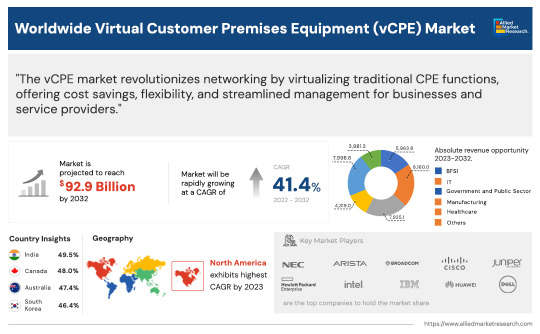#Data Center Virtualization Market
Explore tagged Tumblr posts
Text
#Data Center Virtualization Market#Data Center Virtualization Market Scope#Data Center Virtualization Market Size#Data Center Virtualization Market Analysis#Data Center Virtualization Market Growth#Data Center Virtualization Market Trends
2 notes
·
View notes
Text
#Data Center Virtualization Market size#Data Center Virtualization Market analysis#Data Center Virtualization Market share
0 notes
Text

Virtual Customer Premises Equipment Market : Global Opportunity Analysis and Industry Forecast, 2023-2032
The virtual customer premises equipment market was valued at $3 billion in 2022, and is estimated to reach $92.9 billion by 2032, growing at a CAGR of 41.4% from 2023 to 2032.
Read More: https://www.alliedmarketresearch.com/virtual-customer-premises-equipment-market-A127111
#Virtual Customer Premises Equipment Market#Virtual Customer Premises Equipment#Infrastructure & Network Security#Data Centers#Telecom Service Providers#Enterprises
0 notes
Text

Accelerate Business Growth in the Digital Era with Blog Writing in Finnish
In today’s digital era, businesses are increasingly recognizing the importance of effective SEO content writing to boost their growth through digital marketing. SEO, or Search Engine Optimization, is the art of optimizing web content to rank higher on search engine result pages, driving organic traffic to a website. It involves incorporating relevant keywords, creating engaging content, and enhancing user experience to attract and retain visitors. With the ever-evolving algorithms of search engines like Google, businesses must adapt their content strategies to stay ahead of the competition.
That’s where skilled SEO content writers come in. They possess the unique ability to blend creativity and technical expertise to craft compelling content that not only resonates with the target audience but also aligns with search engine requirements. By employing effective Blog Writing in Finnish, businesses can reach a wider audience, increase their online visibility, and establish their authority in their respective industries. This not only leads to improved brand recognition but also drives more qualified leads, ultimately contributing to the growth and success of the business.
To read more https://katrium2.wordpress.com/2023/06/05/accelerate-business-growth-in-the-digital-era-with-blog-writing-in-finnish/ Contact +372 56487 414 Mail us [email protected] Address Mustamäe tee, 5-210, Tallinn, Estonia
#BPO services in Finnish#International BPO Outsourcing#Content writing in Finnish#Multilingual Call Center Services#Blog writing in Finnish#Best Proof Reading Service#European Language Translation#Data Collection Service#Data Management Services#International Market Research#Language Translation Service#Multilingual Content Writing#Multilingual Market Research Services#Transcription and translation services#Virtual Assistant Support#24/7 BPO Services#Contact Center Outsourcing#Contact Center Services#Content Writing Services#Customer service in Finnish#Multilingual articles and blog writing services#Online Content Development#Outsourcing Call Center#Professional Content Writing#Small Business Support Services
0 notes
Text
The article under the cut
Allies of Elon Musk stationed within the Education Department are considering replacing some contract workers who interact with millions of students and parents annually with an artificial intelligence chat bot, according to internal department documents and communications.
The proposal is part of President Trump’s broader effort to shrink the federal work force, and would mark a major change in how the agency interacts with the public. The Education Department’s biggest job is managing billions of dollars in student aid, and it routinely fields complex questions from borrowers.
The department currently uses both call centers and a rudimentary A.I. bot to answer questions. The proposal would introduce generative A.I., a more sophisticated version of artificial intelligence that could replace many of those human agents.
The call centers employ 1,600 people who field over 15,000 questions per day from student borrowers.
The vision could be a model for other federal agencies, in which human beings are replaced by technology, and behemoth contracts with outside companies are shed or reduced in favor of more automated solutions. In some cases, that technology was developed by players from the private sector who are now working inside or with the Trump administration.
Mr. Musk has significant interest in A.I. He founded a generative A.I. company, and is also seeking to gain control of OpenAI, one of the biggest players in the industry. At other agencies, workers from the newly created Department of Government Efficiency, headed by Mr. Musk, have told federal employees that A.I. would be a significant part of the administration’s cost-cutting plans.
A year after the Education Department oversaw a disastrous rollout of a new federal student aid application, longtime department officials say they are open to the idea of seeking greater efficiencies, as have leaders in other federal agencies. Many are partnering with the efficiency initiative.
But Department of Education staff have also found that a 38 percent reduction in funding for call center operations could contribute to a “severe degradation” in services for “students, borrowers and schools,” according to one internal document obtained by The Times.
The Musk associates working inside the Education Department include former executives from education technology and venture capital firms. Over the past several years, those industries have invested heavily in creating A.I. education tools and marketing them to schools, educators and students.
The Musk team at the department has focused, in part, on a help line that is currently operated on a contract basis by Accenture, a consulting firm, according to the documents reviewed by The Times. The call center assists students who have questions about applying for federal Pell grants and other forms of tuition aid, or about loan repayment.
The contract that includes this work has sent more than $700 million to Accenture since 2019, but is set to expire next week.
“The department is open to using tools and systems that would enhance the customer service, security and transparency of data for students and parents,” said Madi Biedermann, the department’s deputy assistant secretary for communications. “We are evaluating all contracts to assess effectiveness relative to costs.”
Accenture did not respond to interview requests. A September report from the Education Department describes 1,625 agents answering 462,000 calls in one month. The agents also handled 118,000 typed chats.
In addition to the call line, Accenture provides a broad range of other services to the student aid system. One of those is Aidan, a more rudimentary virtual assistant that answers basic questions about student aid. It was launched in 2019, during Mr. Trump’s first term.
Accenture reported in 2021 that Aidan fielded 2.2 million messages in one year. But its capabilities fall far short of what Mr. Musk’s associates envision building using generative A.I., according to the internal documents.
Both Mr. Trump and former President Joseph R. Biden Jr. directed federal agencies to look for opportunities to use A.I. to better serve the public.
The proposal to revamp the communication system follows a meltdown in the rollout of the new Free Application for Federal Student Aid, or FAFSA, last year under Mr. Biden. As FAFSA problems caused mass confusion for students applying for financial aid, several major contractors, including Accenture, were criticized for breakdowns in the infrastructure available to students and parents seeking answers and help.
From January through May last year, roughly three-quarters of the 5.4 million calls to the department’s help lines went unanswered, according to a report by the Government Accountability Office.
More than 500 workers have since been added to the call centers, and wait times were significantly reduced, according to the September Department of Education report.
But transitioning into using generative A.I. for student aid help, as a replacement for some or all human call center workers, is likely to raise questions around privacy, accuracy and equal access to devices, according to technology experts.
Generative A.I. systems still sometimes share information that is false.
Given how quickly A.I. capabilities are advancing, those challenges are potentially surmountable, but should be approached methodically, without rushing, said John Bailey, a fellow at the American Enterprise Institute and former director of educational technology at the Education Department under President George W. Bush.
Mr. Bailey has since become an expert on the uses of A.I. in education.
“Any big modernization effort needs to be rolled out slowly for testing, to see what works and doesn’t work,” he said, pointing to the botched introduction of the new FAFSA form as a cautionary tale.
“We still have kids not in college because of that,” he said.
In recent weeks, the Education Department has absorbed a number of DOGE workers, according to two people familiar with the process, who requested anonymity because they were not authorized to discuss the department’s security procedures and feared for their jobs.
One of the people involved in the DOGE efforts at the Education Department is Brooks Morgan, who until recently was the chief executive of Podium Education, an Austin-based start-up, and has also worked for a venture capital firm focused on education technology, according to the two people.
Another new staffer working at the agency is Alexandra Beynon, the former head of engineering at Mindbloom, a company that sells ketamine, according to those sources and an internal document.
And a third is Adam Ramada, who formerly worked at a Miami venture capital firm, Spring Tide Capital, which invests in health technology, according to an affidavit in a lawsuit filed against the Department of Government Efficiency.
None of those staffers responded to interview requests.
41 notes
·
View notes
Text

==>

==>

The anthem of absolution is a gentle song. Sussurant whispers through the background of your life in time with the metronome tick of the doomsday clock in your dreams, now magnified by the empty rolling plains into a proclamation of triumph. For the first time in ten years you step outside your prison, and for the first time in your nineteen years you see a blue sky.
>Frolic through the seussian fields

Yeah this is pretty great.
>Find your next victim

Your big-ass ella purnell eyes spot a lone IMP clinging to a nearby pylon.
>Aim

==>

==>

==>

==>

==>

HAMSTERSPRITE: Nice shot.
>Level up

As you reach the respectable rank of MAXFEASANCE AGENT on your ECHELADDER for your accomplishment--the value of the single BOONCOIN in your GRIFTWALLET responding appropriately with your new notoriety--it occurs to you that in your excitement, you're skipping pretty far ahead in the timeline. What, do you expect a hypothetical audience to have some preexisting framework by which they could intuit the context of your adventure or something? That would be silly.
>Rewind a bit.

No, no, too far back.
>Skip ahead.

Oh come on! Spoilers!
>Find a happy medium between past and future.

That's more like it.
Your name is QIRSMIT though you prefer to go by SMITTY to your extremely small circle of online friends. You live on the tidally locked techno-industrial powerhouse planet of LUSTRIUM, an arbitrarily large number of years in the future removed from the hypothetical audience to this internal monologue. That planet will be destroyed shortly, this you know, or at least have a pretty good hunch about.
This is because you are some kind of PROPHET, with the ability to foretell disaster derived from the strings of numbers you see in your dreams. You turn these numbers into STATISTICAL DATAPOINTS that you compare to the present performance of the Lustrium economy to predict IMMANENTLY DEPRECIATING STOCKS AND CURRENCIES with unerring accuracy.
This has been your job for your entire life, ever since your adoption by the cyborg broker hivemind known collectively as the SHAREBEARS, after you were delivered to the roof of their building by a fortuitous meteor. While not particularly personable, they are attentive to your needs and quick to indulge the many interests you pursue in your free time.
These interests include OLD EARTH MOVIES though the films the Sharebears obtain for you are more often than not related to the stock market and/or data analytics. You enjoy a well-plotted graph, but in your free time you prefer the more mystical studies of SACRED GEOMETRY and OBJECTS OF MATHEMATICAL INTRIGUE.
You enjoy building elaborate MARBLE COURSES and running races, both because it is a practical study of PHYSICS AND ENTROPY as well as very fun to see little glass balls roll down a chute. You have damn good aim with a SLINGSHOT too in case those little glass balls aren’t moving fast enough.
You have an interest in the ancient art of the JAPANESE MANGA and own rare print volumes of your favorite series. You can also amuse yourself for many hours by playing with your dear PET HAMSTER. You are also a bit of a GAMER, particularly virtual reality and simulation games as a substitute for rather limited freedom.
You used to have a lot more freedom, but as the lynchpin of the Sharebears operation there have been several attempts on your life by rival broker organizations over the years. One psychic attack nearly succeeded, resulting in a long stay on the PSYCH MOON to restore your capabilities.
==>

Now you spend your nights floating in a somnotank of PSYGEL to insulate your mind against unseen threats, and live inside a hermetically sealed reinforced glass bunker at the center of the Sharebears cavernous trading floor. The value of your abilities has provided you with a comfortable life and secure employment, you couldn’t ask for more and on Lustrium alone there are much worse ways to live.
But you often wish you didn’t feel so…bunkertrapped. dwellingenclosed. abodenfixed. There’s probably a good word for it.
>Examine Shorts poster.

SHORTS is your favorite film of all time, quite possibly the greatest film ever made. Given to you by the Sharebears after a misinformed assumption about it's content due to the title. On first watch, your eyes were opened to a world of compelling nonlinear narrative structure, the antique but timeless humor of the year 2009, and whimsical all-ages wishing-rock-related hijinks. You have watched it many times since.
==>

You dearly wish Toby “Toe” Thompson, Loogie Short, and “Nose” Noseworthy could be your friends. Helvetica Black was your first crush, and while you since question your prepubescent taste, there is something undeniably attractive about a girl with a rocket bike who can turn into a giant wasp. You assume the characters in the film are either entirely fictional, or as you have more recent reason to believe, long dead.
>Look at wishing rock.

For your fascination with the film is also a matter of predestination. When you arrived on Lustrium as a meteor-borne infant, one of the things you brought with you was a rainbow-colored rock. Pretty but unremarkable, until your first exposure to Shorts led you to the astounding discovery that your mundane trinket was the very same wishing rock from the film. There is simply no other explanation.
However, your rock does not grant wishes, you assume it’s power was either exhausted, or it is waiting for the right conditions to activate once more.
You have written up a long list of carefully-worded possible wishes in anticipation of the day it does.
From a speculative rp project with @alpha-bread and @scrambo surrounding an oc sburb session. Got bit by the homestuck artbug HARD and figured I'd compile my work thus far.
50 notes
·
View notes
Text
On Tuesday morning, five days after Hurricane Helene ripped through Boone, North Carolina, David Marlett was on his way to the campus of Appalachian State University. The managing director of the university’s Brantley Risk & Insurance Center, Marlett was planning to spend the day working with his colleagues to help students and community members understand their insurance policies and file claims in the wake of the storm. He didn’t sound hopeful. “I’m dreading it,” he said. “So many people are just not going to have coverage.”
Helene made landfall southeast of Tallahassee, Florida, last week with winds up to 140 miles per hour, downing trees and bringing record-breaking storm surges to areas along the Gulf Coast before charging up through Georgia. But perhaps its most shocking impacts have been on inland North Carolina, where it first started raining while the storm was still over Mexico. At least 57 people are dead in Buncombe County in the west of the state alone. Communities like Boone received dozens of inches of rainfall despite being hundreds of miles from the coast. Waters rose in main streets, sinkholes and mudslides wreaked havoc, and major roads were blocked, flooded, or degraded by the storm.
Now, there’s a good chance that many homeowners in North Carolina won’t see any payouts from their insurance companies—even if they have policies they thought were comprehensive.
“The property insurance market for homes was already a patchwork system that really doesn’t make a lot of sense,” Marlett says. “Now you’re adding in the last couple of years of economic uncertainty, inflation, climate change, population migration—it’s just an unbelievably bad combination happening all at once.”
For North Carolinians, the issue right now has to do with what, exactly, private insurance is on the hook for when it comes to a storm. An average homeowner policy covers damage from wind, but private homeowners’ insurance plans in the US do not cover flooding. Instead, homeowners in areas at risk of flooding usually purchase plans from the National Flood Insurance Program (NFIP).
The way a hurricane wreaks havoc on a state is a crucial deciding factor for insurers’ wallets. Hurricane Ian, which hit Florida as a category 4 storm with some of the highest wind speeds on record, caused $63 billion in private insurance claims. In contrast, the bulk of the $17 billion in damage caused by 2018’s Hurricane Florence, which tore up the North Carolina coast, was water damage, not wind; as a result, private insurers largely avoided picking up the check for that disaster.
This breakout of flood insurance from home policies dates back to the 1940s, says Donald Hornstein, a law professor at the University of North Carolina and a member of the board of directors of the North Carolina Insurance Underwriting Association. Private insurance companies decided that they did not have enough data to be able to accurately predict flooding and therefore could not insure it. “In some ways, that calculation of 50 years ago is still the calculation insurers make today,” he says.
While the NFIP, which was created in the late 1960s, provides virtually the only backup against flood damage, the program is saddled with debt and has become a political hot potato. (Project 2025, for instance, recommends phasing out the program entirely and replacing it with private options.) Part of the problem with the NFIP is low uptake. Across the country, FEMA statistics show that just 4 percent of homeowners have flood insurance. Some areas hit by Helene in Appalachia, initial statistics show, have less than 2.5 percent of homeowners signed up for the federal program.
“Even in coastal areas, not many people buy that, much less here in the mountains,” Marlett says. “People have never seemed to fully understand that flood is a separate policy.”
Flooding is not unprecedented in the mountains of North Carolina: Hurricane Ivan swept through Appalachia in 2004, and flash floods from rivers are not unheard of. Purchasing flood insurance is mandatory with a government-backed mortgage in some areas of the country, based on flood zones set by FEMA. But the data is based on extremely outdated floodplain maps that have not taken the most recent climate science on record rainfall into account.
“The biggest non-secret in Washington for decades is how hopelessly out of date these flood maps are,” Hornstein says.
Even if water wasn’t the cause of destruction for some homeowners in North Carolina, the storm’s disastrous mudslides—another risk supercharged by climate change—may not be covered either. Many home insurance policies have carve-outs for what are known as “earth movements,” which includes landslides, sinkholes, and earthquakes. In some states, like California, insurers are mandated to offer additional earthquake insurance, and homeowners can purchase private additional policies that cover earth movements. But in a state like North Carolina, where earthquake risk is extremely low, homeowners may not even know that such policies exist.
It’s also been a tough few years for the insurance industry across the country. A New York Times analysis from May showed that homeowners’ insurers lost money in 18 states in 2023—up from eight states in 2013—largely thanks to expensive disasters like hurricanes and wildfires. Payouts are increasingly costing insurers more than they are getting in premiums. Homeowners are seeing their policies jump as a result: According to statistics compiled by insurance comparison shopping site Insurify, the average annual cost of home insurance climbed nearly 20 percent between 2021 and 2023. In Florida, which has the highest insurance costs in the country, the average homeowner paid over $10,000 a year in 2023—more than $8,600 above the national rate.
Florida has made headlines in recent months as ground zero for the climate-change insurance crisis. More than 30 insurance companies have either fully or partially pulled out of Florida over the past few years, including big names like Farmers’ and AAA, after mounting losses from repeated major hurricanes like 2022’s Ian, the most expensive natural disaster in the state’s history. Florida’s insurer of last resort, now saddled with risk from multiple homeowners, has proposed a rate increase of 14 percent, set to go into effect next year.
In comparison, North Carolina’s insurance market looks pretty good. No insurers have exited the state since 2008, while homeowners pay an average of $2,100 per year—high, but avoiding the sky-high rates of states like Florida, California, and Texas.
“What traditionally has happened is that there’s a rate increase every few years of 8 to 9 percent for homeowner’s insurance,” says Hornstein. “That has kept the market stable, especially when it comes to the coast.”
But as natural disasters of all kinds mount, it’s tough to see a way forward for insurance business as usual. The NFIP is undergoing a series of changes to update the way it calculates rates for flood insurance—but it faces political minefields in potentially expanding the number of homeowners mandated to buy policies. What’s more, many homeowners are seeing the prices for their flood insurance rise as the NFIP adjusts its rates for existing floodplains using new climate models.
Many experts agree that the private market needs to reflect in some way the true cost of living in a disaster-prone area: in other words, it should be more expensive for people to move to a city where it’s more likely your house will be wiped off the map by a storm. The cost of climate change does not seem to be a deterrent in Florida, one of the fastest-growing states in the country, where coastal regions like Panama City, Jacksonville, and Port St. Lucie are booming. (Some research suggests that the mere existence of the NFIP shielded policyholders from the true costs of living in flood-prone areas.)
Asheville, at the heart of Buncombe County, was once hailed as a climate haven safe from disasters; the city is now reeling in the wake of Helene. For many homeowners, small business owners, and renters in western North Carolina, the damage from Helene will be life-changing. FEMA payouts may bring, at best, only a fraction of what a home would be worth. Auto insurance generally covers all types of damage, including flooding—a small bright spot of relief, but not enough to offset the loss of a family’s main asset.
“People at the coast, at some point after the nth storm, they start to get the message,” Hornstein says. “But for people in the western part of the state, this is just Armageddon. And you can certainly forgive them for not having before appreciated the fine points of these impenetrable contracts.”
Marlett says that there are models for insurance that are designed to better withstand the challenges of climate change. New Zealand, for instance, offers policies that cover all types of damage that could happen to your house; while these policies are increasingly tailored price-wise to different types of risk, there’s no chance a homeowner would experience a climate disaster not covered by their existing policies. But it’s hard, he says, to see the US system getting the wholesale overhaul it needs, given how long the piecemeal system has been in place.
“I sound so pessimistic,” he said. “I’m normally an optimistic person.”
30 notes
·
View notes
Text












A City Lost in the Neon Abyss
The central hub of the cybercity looms like a massive shadow against the skyline, its black surfaces absorbing all light except for the intense purple neon grids that pulse like a digital heartbeat. Towering skyscrapers with razor-sharp edges are adorned with holographic projections of cyber-deities, their digital eyes scanning the masses below. The streets are alive with synthetic fog and neon reflections, where cyborg traders barter in underground markets beneath the ever-watchful AI security drones. At the city’s core, a singular obsidian tower—the seat of the metropolis’s corporate rulers—pulses with the glow of infinite data streams, a beacon of power in a world consumed by the neon abyss.
A sprawling black cityscape stretches into infinity, its skyline broken only by the luminous pulse of violet neon coursing through the veins of its megastructures. In the city center, a towering monument of glass and steel—known as the Neon Monolith—stands as the ultimate seat of AI control. The streets below are illuminated by electric purple signs, advertising bio-mechanical enhancements and virtual reality escapes. Beneath the hovering highways, shadowy figures exchange stolen data chips in the neon haze, while AI-controlled enforcers patrol the upper levels, scanning the streets for signs of rebellion. The city hums with a synthetic life force, an ecosystem of code and electricity, where reality and the digital world blur into one.
A neon-lit superstructure dominates the cybercity’s central district, its blackened towers stretching skyward with jagged, glowing edges. At the city’s core, a colossal data hub glows with an eerie purple radiance, sending encrypted transmissions across the skyline. Streets of obsidian steel pulse with violet LED pathways, guiding autonomous vehicles and cybernetic citizens through the digital maze. Above, hover-trams streak across glowing rails, their silhouettes flickering against the neon horizon. AI-driven street monitors flash cryptic messages, warning of resistance groups forming in the shadows, just beyond the reach of the omnipresent surveillance.
#artwork#artists on tumblr#digital art#digital illustration#character design#digital painting#art#doodle#animation#drawing#lapak303
4 notes
·
View notes
Text
Benefits Of Conversational AI & How It Works With Examples

What Is Conversational AI?
Conversational AI mimics human speech. It’s made possible by Google’s foundation models, which underlie new generative AI capabilities, and NLP, which helps computers understand and interpret human language.
How Conversational AI works
Natural language processing (NLP), foundation models, and machine learning (ML) are all used in conversational AI.
Large volumes of speech and text data are used to train conversational AI systems. The machine is trained to comprehend and analyze human language using this data. The machine then engages in normal human interaction using this information. Over time, it improves the quality of its responses by continuously learning from its interactions.
Conversational AI For Customer Service
With IBM Watsonx Assistant, a next-generation conversational AI solution, anyone in your company can easily create generative AI assistants that provide customers with frictionless self-service experiences across all devices and channels, increase employee productivity, and expand your company.
User-friendly: Easy-to-use UI including pre-made themes and a drag-and-drop chat builder.
Out-of-the-box: Unconventional To better comprehend the context of each natural language communication, use large language models, large speech models, intelligent context gathering, and natural language processing and understanding (NLP, NLU).
Retrieval-augmented generation (RAG): It based on your company’s knowledge base, provides conversational responses that are correct, relevant, and current at all times.
Use cases
Watsonx Assistant may be easily set up to accommodate your department’s unique requirements.
Customer service
Strong client support With quick and precise responses, chatbots boost sales while saving contact center funds.
Human resources
All of your employees may save time and have a better work experience with HR automation. Questions can be answered by staff members at any time.
Marketing
With quick, individualized customer service, powerful AI chatbot marketing software lets you increase lead generation and enhance client experiences.
Features
Examine ways to increase production, enhance customer communications, and increase your bottom line.
Artificial Intelligence
Strong Watsonx Large Language Models (LLMs) that are tailored for specific commercial applications.
The Visual Builder
Building generative AI assistants using to user-friendly interface doesn’t require any coding knowledge.
Integrations
Pre-established links with a large number of channels, third-party apps, and corporate systems.
Security
Additional protection to prevent hackers and improper use of consumer information.
Analytics
Comprehensive reports and a strong analytics dashboard to monitor the effectiveness of conversations.
Self-service accessibility
For a consistent client experience, intelligent virtual assistants offer self-service responses and activities during off-peak hours.
Benfits of Conversational AI
Automation may save expenses while boosting output and operational effectiveness.
Conversational AI, for instance, may minimize human error and expenses by automating operations that are presently completed by people. Increase client happiness and engagement by providing a better customer experience.
Conversational AI, for instance, may offer a more engaging and customized experience by remembering client preferences and assisting consumers around-the-clock when human agents are not present.
Conversational AI Examples
Here are some instances of conversational AI technology in action:
Virtual agents that employ generative AI to support voice or text conversations are known as generative AI agents.
Chatbots are frequently utilized in customer care applications to respond to inquiries and offer assistance.
Virtual assistants are frequently voice-activated and compatible with smart speakers and mobile devices.
Software that converts text to speech is used to produce spoken instructions or audiobooks.
Software for speech recognition is used to transcribe phone conversations, lectures, subtitles, and more.
Applications Of Conversational AI
Customer service: Virtual assistants and chatbots may solve problems, respond to frequently asked questions, and offer product details.
E-commerce: Chatbots driven by AI can help customers make judgments about what to buy and propose products.
Healthcare: Virtual health assistants are able to make appointments, check patient health, and offer medical advice.
Education: AI-powered tutors may respond to student inquiries and offer individualized learning experiences.
In summary
The way to communicate with robots might be completely changed by the formidable technology known as conversational AI. Also can use its potential to produce more effective, interesting, and customized experiences if it comprehend its essential elements, advantages, and uses.
Read more on Govindhech.com
#ConversationalAI#AI#NLP#machinelearning#generativeAI#LLM#AIchatbot#News#Technews#Technology#Technologynews#Technologytrends#Govindhtech
3 notes
·
View notes
Text
How Generative AI is Transforming Telemedicine and Remote Healthcare

Generative AI is rapidly reshaping the landscape of telemedicine and remote healthcare, introducing innovative solutions that enhance patient care and operational efficiency. By leveraging advanced algorithms, generative AI can analyze vast amounts of medical data, create personalized treatment plans, and support clinical decision-making.
One of the most notable contributions of generative AI is its ability to bridge gaps in diagnostic services. AI models can generate insights from medical images, such as X-rays or MRIs, helping healthcare professionals detect conditions early and accurately. These tools are particularly beneficial in underserved regions, where access to specialized care is limited.
Generative AI also plays a pivotal role in improving patient engagement. Chatbots and virtual assistants powered by AI provide round-the-clock support, answering queries, scheduling appointments, and offering tailored health recommendations. This not only improves patient experience but also reduces the burden on healthcare providers.
Furthermore, AI-driven tools are being used to simulate treatment outcomes, enabling doctors to refine approaches before implementation. This predictive capability minimizes risks and ensures more effective care delivery.
As generative AI continues to advance, it holds immense potential to transform telemedicine into a more accessible, efficient, and patient-centered domain. However, addressing ethical concerns, such as data privacy and algorithmic bias, remains critical to unlocking its full potential.
Generative AI is not just a technological trend; it is a driving force in the evolution of modern healthcare, bringing quality care closer to those who need it most.
To know more: data collection services
healthcare market research services
3 notes
·
View notes
Text
#Data Center Virtualization Market#Data Center Virtualization Market Size#Data Center Virtualization Market Scope#Data Center Virtualization Market Analysis#Data Center Virtualization Market Growth#Data Center Virtualization Market Trends#Data Center Virtualization Market Forecast
0 notes
Text
#Data Center Virtualization Market size#Data Center Virtualization Market share#Data Center Virtualization Market forecast#Data Center Virtualization Market analysis
0 notes
Text
Page Optimization Best Practices: A Blueprint for Online Growth
Page optimization is an essential system in virtual advertising and net development that ensures websites are person-friendly, functional, and aligned with seek engine tips. It encompasses quite a few techniques and practices aimed at improving a website's performance, visibility, and general user revel in (UX). By optimizing a page, companies and content creators can achieve better search engine ratings, force organic visitors, and ultimately enhance conversion costs. This complete manual explores the facets of page optimization, from its technical factors to consumer-centered techniques.

On-Page Optimization
The Importance of Page Optimization
In the state-of-the-art competitive digital landscape, merely having an internet site is inadequate. Users anticipate rapid-loading, cellular-friendly, and easily navigable pages. Moreover, serps like Google prioritize web sites that supply value through optimized overall performance. Here’s why page optimization is essential:
Enhanced User Experience: Optimized pages load quickly, are visually appealing and provide intuitive navigation. This maintains users engaged and decreases bounce costs.
Higher Search Engine Rankings: Search engines reward optimized pages with better ratings, growing visibility, and natural reach.
Increased Conversions: A properly optimized web page encourages customers to take desired movements, including creating a purchase, signing up for a publication, or downloading content.
Better Accessibility: Optimization guarantees your content is on the market to all customers, such as people with disabilities, through features like alt textual content and proper structure.
Cost Efficiency: Pages optimized for speed and overall performance lessen server load and bandwidth utilization, reducing hosting expenses.
Key Elements of Page Optimization
Page optimization is multi-faceted, involving each technical and content-associated components. Below, we delve into its middle elements:
Page Speed Optimization
Page speed refers to how quickly a webpage masses its content. It's a crucial rating issue for search engines like Google and Yahoo and significantly affects consumer retention. A postponement of even a 2nd can bring about massive drops in personal engagement and conversions.
Minimize HTTP Requests: Reduce the number of factors like photographs, scripts, and CSS documents.
Compress Images: Use equipment like TinyPNG or ImageOptim to lessen image sizes without compromising quality.
Enable Browser Caching: Cache static files so returning site visitors don’t need to reload all factors.
Use a Content Delivery Network (CDN): Distribute content across more than one server to reduce latency.
Optimize Code: Minify CSS, JavaScript, and HTML to put off unnecessary characters.
Mobile-Friendliness
With over half of internet traffic coming from cellular gadgets, ensuring a web page is cell-pleasant is non-negotiable.
Responsive Design: Use CSS frameworks like Bootstrap to ensure the page adapts to specific screen sizes.
Viewport Settings: Define the viewport for your HTML to govern how your website is displayed on cell devices.
Clickable Elements: Ensure buttons and hyperlinks are properly sized and spaced for touchscreens.
Content Optimization
Content is at the heart of any website. Optimizing content for relevance, readability, and engagement is crucial.
Keyword Research: Identify and use goal key phrases naturally in your content.
Structured Data: Use schema markup to help serps recognize your content material.
Readability: Use brief paragraphs, subheadings, and bullet points to make content material scannable.
Engaging Visuals: Incorporate great images, movies, and infographics to complement textual content.
On-page search engine marketing
On-page search engine marketing entails optimizing character internet pages to rank better in seek engine results.
Title Tags: Create compelling and keyword-rich titles within 50-60 characters.
Meta Descriptions: Write concise descriptions that summarize the page content material and consist of target keywords.
Header Tags (H1, H2, and so forth.): Use headers to shape content material logically and improve readability.
Internal Linking: Link to different applicable pages in your website to enhance navigation and search engine optimization.
Technical Optimization
Technical optimization makes a specialty of backend upgrades to beautify overall performance and seek engine crawlability.
Robots.Txt File: Guide engines like Google on which pages to crawl or ignore.
Canonical Tags: Avoid duplicate content material problems by specifying the favored version of a website.
SSL Certificate: Secure your website online with HTTPS to reinforce consideration and ratings.
404 Error Pages: Create consumer-friendly error pages to guide users to lower back to practical parts of your website online.
Tools for Page Optimization
Several tools can simplify and streamline the optimization manner:
Google PageSpeed Insights: Analyzes web page speed and affords actionable guidelines.
GTmetrix: Offers insights into website performance and areas for development.
Ahrefs/Semrush: Helps with keyword studies, content optimization, and search engine marketing monitoring.
Hotjar: Tracks user behavior via heatmaps and session recordings.
Strategies for Effective Page Optimization
To reap meaningful effects, you want a well-rounded strategy. Here’s a step-by-step approach:
Conduct an Audit
Before enforcing modifications, conduct a comprehensive audit to identify existing troubles. Tools like Screaming Frog or Google Analytics can reveal overall performance bottlenecks, broken hyperlinks, and content gaps.
Prioritize User Intent
Understand your target market's wishes and design pages that cope with them. Whether users are seeking data, products, or services, make certain your content aligns with their intent.
Focus on Core Web Vitals
Google’s Core Web Vitals — Largest Contentful Paint (LCP), First Input Delay (FID), and Cumulative Layout Shift (CLS) — are crucial for web page optimization. Aim to meet their benchmarks for stepped forward user revel in and scores.
Test and Iterate
Optimization is an ongoing system. Use A/B checking out to experiment with web page layouts, calls-to-movement (CTAs), and different elements. Monitor overall performance and refine based on results.
Keep Up with Trends
The digital landscape evolves swiftly. Stay knowledgeable about updates to look engine algorithms, layout developments, and emerging technologies.
Common Challenges and Solutions
While web page optimization gives huge advantages, it also affords challenges:
Balancing Speed and Functionality: Advanced capabilities like animations can sluggish down your website online. Use light-weight libraries and green coding to strike stability.
Content Overload: Too a whole lot of content material can crush users. Focus on turning in concise, cost-driven information.
Managing Multiple Platforms: Ensuring steady overall performance across desktop, cell, and drugs requires thorough testing and responsive design.
The Future of Page Optimization
As technology advances, web page optimization will keep evolving. Emerging tendencies like voice seek, AI-pushed personalization, and augmented truth (AR) integration will redefine consumer expectations. Websites will want to leverage these improvements at the same time as adhering to foundational optimization ideas.
Additionally, the rise of privacy policies emphasizes the want for transparent facts practices. Optimized pages will not only perform nicely but additionally build acceptance as true through secure and ethical dealing with of personal records.
2 notes
·
View notes
Text
Top Futuristic AI Based Applications by 2024
2024 with Artificial Intelligence (AI) is the backdrop of what seems to be another revolutionary iteration across industries. AI has matured over the past year to provide novel use cases and innovative solutions in several industries. This article explores most exciting AI applications that are driving the future.
1. Customized Chatbots
The next year, 2024 is seeing the upward trajectory of bespoke chatbots. Google, and OpenAI are creating accessible user-friendly platforms that enable people to build their own small-scale chatbots for particular use cases. These are the most advanced Chatbots available in the market — Capable of not just processing text but also Images and Videos, giving a plethora of interactive applications. For example, estate agents can now automatically create property descriptions by adding the text and images of listings thatsurgent.
2. AI in Healthcare

AI has found numerous applications in the healthcare industry, from diagnostics to personalized treatment plans. After all, AI-driven devices can analyze medical imaging material more accurately than humans and thus among other things help to detect diseases such as cancer at an early stage. They will also describe how AI algorithms are used to create tailored treatment strategies personalized for each patient's genetics and clinical past, which helps enable more precise treatments.
3. Edge AI
A major trend in 2024 is Edge AI It enables computer processing to be done at the edge of a network, rather than in large data centers. Because of its reduced latency and added data privacy, Edge AI can be used in applications like autonomous vehicles transportations, smart cities as well as industrial automation. Example, edge AI in autonomous vehicles is able to get and process real-time data, increasing security by allowing faster decision-making.
4. AI in Finance

Today, the financial sector is using AI to make better decisions and provide an even stronger customer experience. Fraud detection, risk assessment and customised financial advice have introduced insurance into the AI algorithm. AI-powered chatbots and virtual assistants are now common enough to be in use by 2024, greatly assisting customers stay on top of their financial well-being. Those tools will review your spending behavior, write feedback to you and even help with some investment advices.
5. AI in Education
AI is revolutionizing education with individualized learning. These AI-powered adaptive learning platforms use data analytics to understand how students fare and produces a customised educational content (Hoos, 2017). This way, students get a tailored experience and realize better outcomes. Not only that, AI enabled tools are also in use for automating administrative tasks which shortens the time required by educators on teaching.
6. AI in Job Hunting

This is also reverberating in the job sector, where AI technology has been trending. With tools like Canyon AI Resume Builder, you can spin the best resumé that might catch something eye catchy recruiter among a dozen others applications he receives in-between his zoom meeting. Using AI based tools to analyze Job Descriptions and match it with the required skills, experience in different job roles help accelerating the chances of a right fit JOB.
7. Artificial Intelligence in Memory & Storage Solutions
Leading AI solutions provider Innodisk presents its own line of memory and storage with added in-house designed AI at the recent Future of Memory & Storage (FMS) 2024 event. Very typically these are solutions to make AI applications easier, faster and better by improving performance scalability as well on the quality. This has huge implications on sectors with substantial data processing and storage demands (healthcare, finance, self-driving cars).
Conclusion

2024 — Even at the edge of possible, AI is revolutionizing across many industries. AI is changing our lives from tailored chatbots and edge AI to healthcare, finance solutions or education and job search. This will not only improve your business profile as a freelancer who create SEO optimized content and write copies but also give your clients in the writing for business niche some very useful tips.
#ai#ai in healthcare#ai in finance#ai in wealth management#ai in business#AI trends#artificial intelligence#advanced technologies#innovation#technological advancements
4 notes
·
View notes
Text
Content writing in Finnish
Looking for high-quality content writing in Finnish? Don't look much farther than Katrium! Our team of experienced writers can provide engaging and informative content tailored to your needs. Visit us today to learn more about our services.
Phone No. +372 56487 414 You can mail us at [email protected] Address Mustamäe tee, 5-210, Tallinn, Estonia
#content writing in Finnish#Content writing in Finnish#Multilingual Call Center Services#Blog writing in Finnish#Best Proof Reading Service#Business Support Services#Data Collection Service#Data Management Services#European Language Translation#International Market Research#Language Translation Service#Multilingual Content Writing#Multilingual Market Research Services#Transcription and translation services#Virtual Assistant Support#BPO services in Finnish#International BPO Outsourcing#24/7 BPO Services#Contact Center Outsourcing#Contact Center Services#Content Writing Services#Customer service in Finnish#Multilingual articles and blog writing services#Online Content Development#Outsourcing Call Center#Professional Content Writing#Small Business Support Services
0 notes